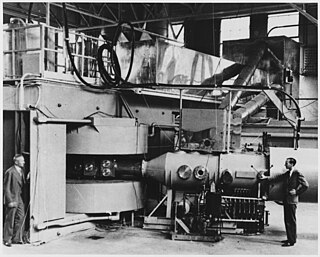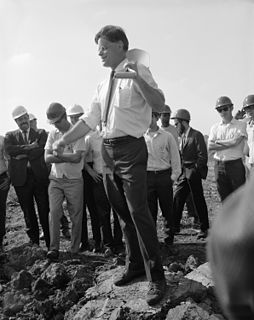
Particle physics is a branch of physics that studies the nature of the particles that constitute matter and radiation. Although the word particle can refer to various types of very small objects, particle physics usually investigates the irreducibly smallest detectable particles and the fundamental interactions necessary to explain their behaviour.

The European Organization for Nuclear Research, known as CERN, is a European research organization that operates the largest particle physics laboratory in the world. Established in 1954, the organization is based in a northwest suburb of Geneva on the Franco–Swiss border and has 23 member states. Israel is the only non-European country granted full membership. CERN is an official United Nations Observer.

A cyclotron is a type of particle accelerator invented by Ernest O. Lawrence in 1929–1930 at the University of California, Berkeley, and patented in 1932. A cyclotron accelerates charged particles outwards from the center of a flat cylindrical vacuum chamber along a spiral path. The particles are held to a spiral trajectory by a static magnetic field and accelerated by a rapidly varying electric field. Lawrence was awarded the 1939 Nobel Prize in Physics for this invention.

Carlo Rubbia, is an Italian particle physicist and inventor who shared the Nobel Prize in Physics in 1984 with Simon van der Meer for work leading to the discovery of the W and Z particles at CERN.

The Deutsches Elektronen-Synchrotron commonly referred to by the abbreviation DESY, is a national research center in Germany that operates particle accelerators used to investigate the structure of matter. It conducts a broad spectrum of inter-disciplinary scientific research in three main areas: particle and high energy physics; photon science; and the development, construction and operation of particle accelerators. Its name refers to its first project, an electron synchrotron. DESY is publicly financed by the Federal Republic of Germany, the States of Germany, and the German Research Foundation (DFG). DESY is a member of the Helmholtz Association and operates at sites in Hamburg and Zeuthen.

SLAC National Accelerator Laboratory, originally named Stanford Linear Accelerator Center, is a United States Department of Energy National Laboratory operated by Stanford University under the programmatic direction of the U.S. Department of Energy Office of Science and located in Menlo Park, California. It is the site of the Stanford Linear Accelerator, a 3.2 kilometer (2-mile) linear accelerator constructed in 1966 and shut down in the 2000s, which could accelerate electrons to energies of 50 GeV.

Fermi National Accelerator Laboratory (Fermilab), located just outside Batavia, Illinois, near Chicago, is a United States Department of Energy national laboratory specializing in high-energy particle physics. Since 2007, Fermilab has been operated by the Fermi Research Alliance, a joint venture of the University of Chicago, and the Universities Research Association (URA). Fermilab is a part of the Illinois Technology and Research Corridor.

A linear particle accelerator is a type of particle accelerator that accelerates charged subatomic particles or ions to a high speed by subjecting them to a series of oscillating electric potentials along a linear beamline. The principles for such machines were proposed by Gustav Ising in 1924, while the first machine that worked was constructed by Rolf Widerøe in 1928 at the RWTH Aachen University. Linacs have many applications: they generate X-rays and high energy electrons for medicinal purposes in radiation therapy, serve as particle injectors for higher-energy accelerators, and are used directly to achieve the highest kinetic energy for light particles for particle physics.
Accelerator physics is a branch of applied physics, concerned with designing, building and operating particle accelerators. As such, it can be described as the study of motion, manipulation and observation of relativistic charged particle beams and their interaction with accelerator structures by electromagnetic fields.

Robert Rathbun Wilson was an American physicist known for his work on the Manhattan Project during World War II, as a sculptor, and as an architect of the Fermi National Accelerator Laboratory (Fermilab), where he was the first director from 1967 to 1978.
A collider is a type of particle accelerator which brings two opposing particle beams together such that the particles collide. Colliders may either be ring accelerators or linear accelerators.

A synchrotron is a particular type of cyclic particle accelerator, descended from the cyclotron, in which the accelerating particle beam travels around a fixed closed-loop path. The magnetic field which bends the particle beam into its closed path increases with time during the accelerating process, being synchronized to the increasing kinetic energy of the particles. The synchrotron is one of the first accelerator concepts to enable the construction of large-scale facilities, since bending, beam focusing and acceleration can be separated into different components. The most powerful modern particle accelerators use versions of the synchrotron design. The largest synchrotron-type accelerator, also the largest particle accelerator in the world, is the 27-kilometre-circumference (17 mi) Large Hadron Collider (LHC) near Geneva, Switzerland, built in 2008 by the European Organization for Nuclear Research (CERN). It can accelerate beams of protons to an energy of 6.5 teraelectronvolts (TeV).

GiacomoBarozzida Vignola, often simply called Vignola, was one of the great Italian architects of 16th century Mannerism. His two great masterpieces are the Villa Farnese at Caprarola and the Jesuits' Church of the Gesù in Rome. The three architects who spread the Italian Renaissance style throughout Western Europe are Vignola, Serlio and Palladio.
A particle beam is a stream of charged or neutral particles, in many cases moving at near the speed of light.
A particle-beam weapon uses a high-energy beam of atomic or subatomic particles to damage the target by disrupting its atomic and/or molecular structure. A particle-beam weapon is a type of directed-energy weapon, which directs energy in a particular and focused direction using particles with minuscule mass. Some particle-beam weapons have potential practical applications, e.g. as an antiballistic missile defense system for the United States and its cancelled Strategic Defense Initiative. They have been known by myriad names: phasers, disruptors, particle accelerator guns, ion cannons, proton beams, lightning rays, rayguns, etc.

Robert G. Vignola was an Italian-American actor, screenwriter, and film director. A former stage actor, he appeared in many motion pictures produced by Kalem Company and later moved to directing, becoming one of the silent screen's most prolific directors. He directed a handful of films in the early years of talkies but his career essentially ended in the silent era.
The Cornell Laboratory for Accelerator-based Sciences and Education (CLASSE) is a particle accelerator facility located in Wilson Laboratory on the Cornell University campus in Ithaca, NY. CLASSE formed from the merger of the Cornell High-Energy Synchrotron Source (CHESS) and the Laboratory for Elementary-Particle Physics (LEPP) in July 2006. Ritchie Patterson is the Director of CLASSE.

A particle accelerator is a machine that uses electromagnetic fields to propel charged particles to very high speeds and energies, and to contain them in well-defined beams.
Lucio Rossi is an Italian physicist who is working in the field of superconductivity. An author of more than 140 publications in international journals and reviews, he has served as a researcher and professor at the University of Milan. Today, he is working at CERN where he is presently the project leader of the HL-LHC project.
Vignola is a municipality in Emilia–Romagna, Italy.












